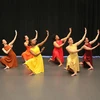A two-year transition plan to restructure Academic Affairs at SUNY Fredonia has been created and will culminate with the creation of two new academic units: the College of Arts and Sciences and the College of Visual and Performing Arts.
To be fully implemented by the fall of 2012, the new organizational chart does resemble, but it’s not exactly, one of the options outlined in December. It is not either of the two options presented at a Jan. 22 meeting or the third option proposed at that session. It is also not the model later recommended by the Planning and Budget Committee and subsequently endorsed by a majority of voting Senators, or even any of the five models that were part of the decision-making matrix at the Academic Affairs VP Council meeting in early February.
“What we have decided is certainly different from what I’d imagined,” acknowledged Vice President for Academic Affairs Virginia Horvath.
The strength of the restructuring that Dr. Horvath presented at a special Academic Affairs meeting Feb. 19, though, is rooted in a final plan that she said was shaped in so many different ways, so many different times and by so many hands. The process has demonstrated that any idea or proposal is made that much stronger when many voices have worked together to articulate it, Dr. Horvath said.
“It’s a vision for Academic Affairs grounded in the essentials of our mission and identity and shaped by the concerns and priorities that emerged in all these conversations and debates,” she said.
The most immediate impact of the new plan is the decision not to launch a dean search or hire an interim dean due to the resignation of Dr. David Ewing, dean of the College of Natural and Social Sciences, who will become dean of the College of Arts and Sciences at Canisius College in June. Leaving his SUNY Fredonia position vacant for two years will not only generate considerable cost savings, estimated at $60,000 per year, but it will also provide valuable transitioning time for the restructured Academic Affairs division.
SUNY Fredonia’s new College of Arts and Sciences will emerge June 1 with Dr. John Kijinski, dean of the current College of Arts and Humanities, as its dean. Two associate deans, to be selected from among tenured faculty, will assist Dr. Kijinski due to the large number of students, faculty and resources within that academic unit. Issues relating to assessment, scheduling, research grants, curriculum, catalog, reports and alumni affairs, among other matters, can be more reasonably addressed by having one dean delegating those responsibilities to associates.
While originally advocating for a strong Dean of Natural and Social Sciences to continue the momentum of growth and development in the sciences, Biology Professor Roger Byrne believes the campus could not afford the time lost under an interim dean or the uncertainty of hiring a good permanent dean who would need some further time to learn how the sciences work here.
Dr. Byrne considers Kijinski to have the experience to take over the sciences right away, and although Byrne has worked with him on only a few projects, he has been impressed with Kijinski’s wisdom, knowledge and commitment to success of his programs. “I am cautiously optimistic that the momentum gained in recent years in the area of science and science education at Fredonia will continue under his leadership, and I look forward to working with him.”
A transition team has been formed to work with deans Kijinski and Ewing, and secretaries from the existing programs will be carried over to facilitate a smooth changeover.
“This structure is not a compromise or a simple cost-savings strategy — or worse yet, a cobbled ‘College of Necessity or Randomness,’” Horvath said. “It is a deliberate choice about who we are and where, for some time, our strengths have been.”
Many universities have a traditional model of a central college of arts and sciences, which is responsible for education, research and service in the foundational disciplines, and that was the case at Idaho State University, where Kijinski served as dean in that capacity before joining SUNY Fredonia in 2007. The new structure affirms the central position of the sciences, humanities, interdisciplinary studies and social sciences as the foundations for learning in all fields, Horvath said. It will not directly impact the School of Business or the College of Education, although their respective deans participated in discussion sessions.
According to Kijinski, the primary benefit of a College of Arts and Sciences is getting faculty who teach the foundational disciplines together at least once a month. “This might sound like a small thing, but it isn’t,” Kijinski said. “It promotes thinking about the central missions of teaching, research and service in the foundational disciplines.”
The second phase of the restructuring will take place in 2011-2012, as the campus considers which programs and departments are best suited within the College of Arts and Sciences and how to better support distinctive interdisciplinary programs that cross traditional learning boundaries. Horvath will look to the Senate Planning and Budget Committee to lead this planning effort.
The final phase will be to establish the College of Visual and Performing Arts in the fall of 2012. Groundwork for this new unit will begin in 2011 with the formation of an advisory board comprised of faculty, staff and alumni. A nationwide search will be launched in 2011-2012 for a dean to be in place in the fall of 2012.
Unifying the various arts programs within one college will help distinguish professional training programs from other curricula on campus, while also distinguishing Fredonia in the SUNY system, said School of Music Director Karl Boelter.
“The arts at Fredonia have pockets of true excellence and appeal on a national scale. The university has the opportunity to bring focus to this aspect of who we are, and to allow the strengths to spread throughout our programs,” Dr. Boelter said.
While this new college structure won’t immediately impact students, Boelter believes that, with vision and planning, all of its programs will unify in recruitment strategies, fundraising goals, objective clarity, more highly visible projects, improved collaboration and overall branding initiatives. “From these kinds of synergies, the students will clearly benefit, and so will our operations,” Boelter added.
Support for a College of Visual and Performing Arts was not limited to those in arts fields but from those in other units who maintained that such a structure is aligned with SUNY Fredonia’s history, strengths and reputation.
“I know that some will be excited to hear these plans, others apprehensive, outraged, disappointed, curious to hear more, indifferent, cynical or itchy to get started,” Horvath said. The views presented by the various campus constituencies were instrumental, she stressed, in shaping the decisions and honoring the interests that were expressed so passionately.
The decisions made for restructuring Academic Affairs have been collaborative, Horvath emphasized, and team effort will be required for their implementation. More than 200 people participated in a facilitated small-group discussion on this issue on Jan. 22, and the University Senate discussed and voted on the matter at a special meeting on Feb. 8.
A common thread among all discussions, be they more formal ones in Senate or committee meetings, or the casual ones happening in hallways and over email, was thoughtful and respectful, Horvath said, which gives her every confidence that the end result of this process will be an even stronger and more highly regarded institution.



